Do you have a heat only boiler?
You will not need to repressurise a regular/heat only boiler as this type of boiler uses a feed and expansion tank to maintain a consistent level of water and pressure in the heating system, so all the information in this article refers to combi and system boilers.
What is boiler pressure?
Boiler pressure is the pressure of hot water circulating through your central heating system.
It is important to maintain your boiler’s optimum pressure level in order for it to heat up your home and supply hot water efficiently.
If the pressure is too high, there is a chance of leaks developing somewhere within your central heating system. If the pressure is too low, your home and hot water might take longer to heat up and your boiler will have to work harder to supply the central heating system with water, resulting in unnecessarily high energy bills!
How do I check my Ideal boiler pressure?
If you have an Ideal combination or system boiler, you will find a pressure gauge on the front of the boiler (if your boiler has a front panel, pull it down and you should see it). Some older Ideal boiler models have a pressure gauge on the underside of the boiler.
The needle on the pressure gauge will be pointing to the current boiler pressure. The pressure gauge will have an indication of the range where your boiler pressure should be within. This will be indicated by the two green lines (see image).
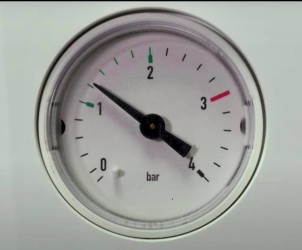
What should my Ideal boiler pressure be?
Your Ideal boiler pressure will change depending on whether it is in use or not, but its optimum range is between 1 and 1.5 bar.
When in use
When your boiler is in use, the pressure should not go higher than 2 bar. When your boiler is in use, the water in the system heats up and expands, causing the boiler pressure to increase, but it should not go above 2 bar.
When not in use
When your boiler is not in use, the pressure should be between 1 and 1.5 bar. If the pressure is below 1 bar, your boiler may not work and it will display an error code telling you that you need to top up the pressure.
How will I know if my Ideal boiler pressure is too low?
- Your radiators are not warming up properly
- There is no heating or hot water
- The needle on the pressure gauge has dropped below 1 bar
- Your Ideal boiler is showing fault code L1, F1 OR E1
Why is my Ideal boiler pressure low?
Low boiler pressure is a common problem with most boiler systems. There could be a number of reasons why your Ideal boiler pressure has dropped. Let’s explore a few of the most common reasons.
Your boiler hasn’t been used much for a long time
Your boiler may have lost pressure simply because it hasn’t been used much, like during the summer when you haven’t needed to turn on the heating, or if it’s been idle for a long time, like if you have been away on holiday.
If this is the case, then the fix is easy- use the boiler. Turn on your central heating to get some hot water circulating through the system. Your Ideal boiler pressure should get back to normal once you have started to use it again.
You have recently bled your radiators
If you have recently bled your radiators, then water and trapped air has been released from the system, resulting in your boiler pressure dropping. The released air will need to be replaced with water in order to get the pressure back up.
You can find out how to do this further down in this guide.
There is a leak somewhere in the system
A leak in your central heating system will reduce the amount of water flowing through it and will result in a loss of pressure.
The most common place to check for leaks is around the pipework that connects to your radiators. If you see puddles of water or other signs of moisture underneath pipework or around radiators, then this could be a sign of a leak. Try not to confuse condensation on pipes or radiators in colder rooms with signs of a leak.
You may not always get such an obvious sign of a leak as a puddle of water underneath pipework or radiators. Slow leaks can often evaporate before they turn into puddles, especially in warm rooms. Have a look for clean spots on hard floors that are surrounded by dust, as it may be a sign of dried water. Also check ceilings for water stains. Tiny leaks are subtle and can be hard to spot, but if they go unnoticed, they will cause your boiler pressure to drop over time.
If there is a leak in your system, you will need a professional to fix it.
Too much pressure in the system
It might seem like a contradiction, but low pressure can be caused by the pressure in the system being too high.
Your system will have a pressure relief valve. A pressure relief valve is essentially a tap that opens and closes to help prevent a buildup of pressure. If the pressure level is too high, the valve will open to release some pressure and then close again once the pressure has dropped back down to a safe level.
If the pressure in the system is a little too high when the system isn’t in use, turning it on again will increase the pressure even more, resulting in the pressure relief valve opening to release water to protect the system. Once the system is off again, the pressure might drop significantly. This is why when you are repressurising the system, it is important to not top it up above the recommended pressure level of 1 bar.
Let us fix your boiler.
At Smart Plan we have thousands of engineers up and down the country who are ready to fix your issue. We guarantee an engineer to your property within 48 hours.
If any of the three above issues aren’t the cause of your Ideal boiler pressure being lower than it should be, then it is likely that there is a fault that you won’t be able to find and fix yourself.
Below are a few common technical issues that might be causing your Ideal boiler pressure to drop. These issues can only be fixed by a boiler engineer.
Your pressure relief valve is faulty or damaged
The pressure relief valve is connected to a discharge pipe, which is a small copper pipe that is located on the external wall behind your combi boiler and is used to release water from your boiler when the pressure reaches a critical level.
Water should only be released via the discharge pipe if the boiler pressure is high.
If you have access to the discharge pipe, check it to see if there is water dripping or running out of it. If you have low boiler pressure and the discharge pipe is releasing water, then it could be a sign that the pressure relief valve is faulty or damaged.
If the pressure relief valve is damaged or is leaking, then like any other leak in the system, it will cause your boiler pressure to drop.
A faulty or damaged pressure relief valve will need to be fixed or replaced by a boiler engineer.
The pump is faulty or damaged
In all pressurised central heating systems, there is a pump that helps get hot water through the system to your radiators, taps, showers, etc.
If you have a regular or system boiler, you will have an external pump that should be located next to the boiler or in the airing cupboard. If you have a combi boiler, then the pump will be inside the boiler itself.
If the pump isn’t working as it should, it could cause a drop in boiler pressure. For example, if the pump's speed is too high, it could cause air bubbles to enter the flow of water, which will result in a drop in pressure. Or if you have a damaged pump, it will struggle to pump hot water around the system at the right pressure.
Expansion vessel not working
An expansion vessel is a small tank that can be found in most pressurised heating systems. Its purpose is to protect the system from excessive pressure caused by the expansion of water. When water heats up it expands, and when it cools it contracts. If nothing was done to accommodate this expansion, the pressure in the system would increase to dangerous levels.
The tank has two sections, separated by a rubber sheet known as a ‘diaphragm’. On one side of the diaphragm is the pressurised water from the central heating system, and on the other side is compressed air. When the temperature rises, the volume of water increases and pushes the diaphragm towards the air. When the water cools, the air pressure in the expansion vessel pushes against the water, maintaining the correct level of pressure in the system.
If the rubber diaphragm is torn, water will fill the gap, and the pressure in the system will decrease.
If your boiler ever experiences a sudden drop in pressure and there are no obvious signs of a leak, this could be the issue. If you suspect this is the cause then DO NOT repressurise the central heating system as the increase in pressure without a functioning expansion vessel could cause a boiler failure.
There is a problem with the air vents
Most modern systems have air vents built in. The purpose of these vents is to relieve air buildup before it becomes an issue. If the air vent is blocked or damaged, air will get into the system and cause the pressure to drop.
How can I increase my Ideal boiler pressure?
If you have an Ideal combi or system boiler, you can easily top up its pressure using the following method. (Regular/heat only boilers never need repressurising as excess pressure is released via its feed and expansion tank.)
Use the filling loop
You can top up your Ideal boiler pressure with the use of its filling loop. The filling loop is what allows water to enter the system from the mains water supply and consists of a small detachable pipe or hose and two handles. Your Ideal boiler’s filling loop will be located on the underside of the boiler, towards the right. When the filling loop is connected and both handles are open, water from the mains supply enters the system to increase the pressure.
The right side of the filling loop is often already connected, so you should only need to attach the left side of the filling loop to the pipe when attempting to repressurise the system.
If both sides of the filling loop are
Follow these steps to increase your Ideal boiler pressure:
- Ensure both handles are in a closed position. You will know that they are both off if they are NOT in line with the piping (see image).
- Now that you have made sure that the handles are in the off position, you can remove the black plug cap from the filling loop.
- Connect the end of the filling loop to the pipe on the left and tighten it. Also, ensure that the other end of the filling loop is hand tight.
- Once you have made sure both ends of the filling loop are tight, it is time to let in water from the mains supply into the central heating system.
The handle on the left hand side of the filling loop is connected to the cold mains supply. Slowly turn this handle towards you. The handle should now be horizontally in line with the pipe (see image). - Now that you have let in water from the DHW inlet, it is now time to let it into the central heating system.
Ensuring no leaks are seen, slowly turn the handle on the right towards you so it is horizontally in line with the pipe. - Water will now be entering your central heating system, so you will need to keep an eye on the pressure gauge.
Once the pressure gauge reaches 1 bar, turn BOTH handles back to their closed position. Your Ideal boiler pressure should now be within its optimal range. - It's now time to disconnect the filling loop. You might want to get an old towel or some tissue, as when you disconnect the filling loop, any water left inside it will trickle out.
Unscrew the left hand side of the filling loop to disconnect it. Replace the black plug cap.
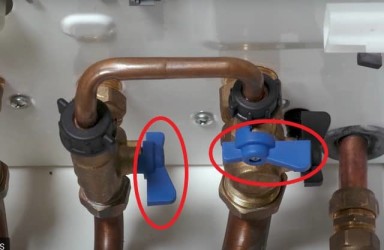
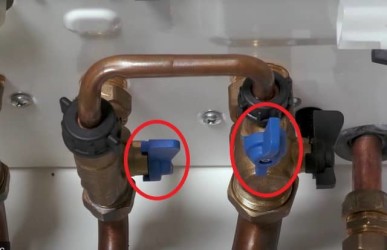
Please note
If your boiler has lost pressure as a result of a fault, increasing its pressure may only be a temporary fix. If you top up your Ideal boiler pressure but it still keeps on losing pressure, then it is time to call in a professional to get to the root cause of your pressure issues.
Avoid unexpected costs.
With a Smart Plan cover policy, you can rest easy knowing if there's an issue with your boiler, we'll usually have you back up and running within 48 hours.
How will I know my Ideal boiler pressure is too high?
- Your boiler is making a rattling or humming noise
- The needle on the pressure gauge is above 2 bar
- Your Ideal boiler is showing fault code L9, H9, HA or LA
Why is my Ideal boiler pressure high?
There could be a number of reasons why your Ideal boiler pressure is high. We’re going to touch on a few of the most common reasons.
The water pressure was topped up too much
Your boiler may have had low pressure and you used the steps highlighted in the previous section to increase the pressure. You may have topped up the pressure a bit too much and ended up tipping it over 1.5 bar.
As mentioned earlier in this article, when boilers are in use, the water in the central heating system expands, which results in a rise in pressure. So if you topped up the boiler over 1.5 bar, then the increase in pressure when it is in use could tip it over its optimum level.
The filling loop is open
If your Ideal boiler pressure is high, the first thing you should do is check your filling loop. As you know by now, the filling loop is used to allow water from the mains into your central heating system when you need to top up your boiler pressure.
It could be possible that someone opened the filling loop to top up the system but forgot to disconnect and completely turn off the handles. If the handles are in line with the pipe, it means they are open. If this is the case, water from the mains will continue to fill up your central heating system. This continued water flowing into the system will raise the pressure in your boiler.
Click here to see how the filling loop handles should look when they are in the off position.
Faulty pressure relief valve
As previously mentioned, the pressure relief valve prevents a buildup of pressure in the system. Over time, a pressure relief valve can wear out and not work as it should. If this is the case, then it will not be able to do its job efficiently and might not release water when the pressure gets too high.
Faulty or damaged expansion vessel
Your combination boiler’s expansion vessel helps to maintain the correct pressure level and prevents sudden changes. Too little air in the expansion valve and the pressure could become too high, resulting in the pressure relief valve releasing water. Too much air in the expansion vessel could result in your system being over pressurised and will also result in the pressure relief valve releasing water. If the expansion vessel is faulty or damaged, then it won't be able to do its job properly and could be the cause of the rise in boiler pressure.
If there is a problem with your boiler’s expansion vessel, then it will need to be fixed or replaced by a boiler engineer.
How can I decrease my Ideal boiler pressure?
Bleed a radiator
You will most likely need a radiator key to bleed your radiator. This is a small butterfly-shaped key. If you don’t have one, you can buy one from your local DIY shop.
You can easily bleed your radiators by following these few steps:
- Make sure your central heating system is turned off
- Place a jug underneath the bleed valve on the radiator to catch the water that will be released once you start bleeding the radiator
- Insert the radiator key into the radiator bleed valve and turn it slowly in an anti-clockwise direction
- Allow some water and air to be released from the radiator
Close the valve by turning the radiator key clockwise- Check the pressure gauge on your Ideal boiler. If it hasn’t gone down enough then you may need to bleed the radiator a bit more
- Once your Ideal boiler pressure is 1 bar, turn your heating back on and check that the radiators are heating up properly
Open the filter or drain-off valve
Most central heating systems have a filter. The purpose of the filter is to remove impurities from the water that flows through the system. The filter can also be used as a drainage valve to relieve pressure in the system.
The filter can normally be found on the piping underneath your boiler (see image below) and will have a valve on the underside of it.
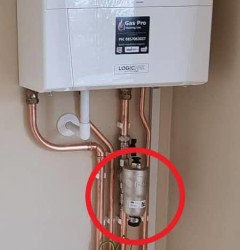
If you don’t have a system filter, then you probably have a drain-off valve instead. It will be a Y-shaped or T-shaped component and will require a spanner to open. Drain-off valves could be located anywhere in the central heating system’s piping but they are often located on the piping close a radiator. (see image below).
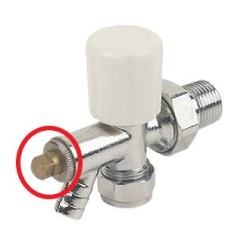
To use the filter or drain-off valve to decrease you Ideal boiler pressure, follow these three simple steps:
- Put a bucket under the filter or drain-off valve
- Open the valve and keep an eye on the pressure gauge
- Close the valve once the pressure gauge reaches 1 bar
Have your boiler serviced annually
If you haven’t had your boiler serviced in the past 12 months, then you should book one as soon as possible. An annual boiler service should reveal any issues in your system.
If your boiler is under warranty and the boiler pressure problem has been caused as a result of defective workmanship, Ideal will repair or replace it free of charge, subject to terms and conditions.
For more information on Ideal boiler warranties, click here.
Give your boiler a service.
Make sure you don't invalidate your warranty. Call Smart Plan to get a boiler checkup to see if everything is in good working order.
What can I do if I can’t fix my Ideal boiler pressure problem myself?
If you have tried the methods mentioned in this article to increase or decrease your Ideal boiler pressure but your boiler pressure issues still keep coming back and you’re not sure why, then contact a Gas Safe registered engineer to have a look at your boiler.Let us fix your boiler.
At Smart Plan we have thousands of engineers up and down the country who are ready to fix your issue. We guarantee an engineer to your property within 48 hours.


